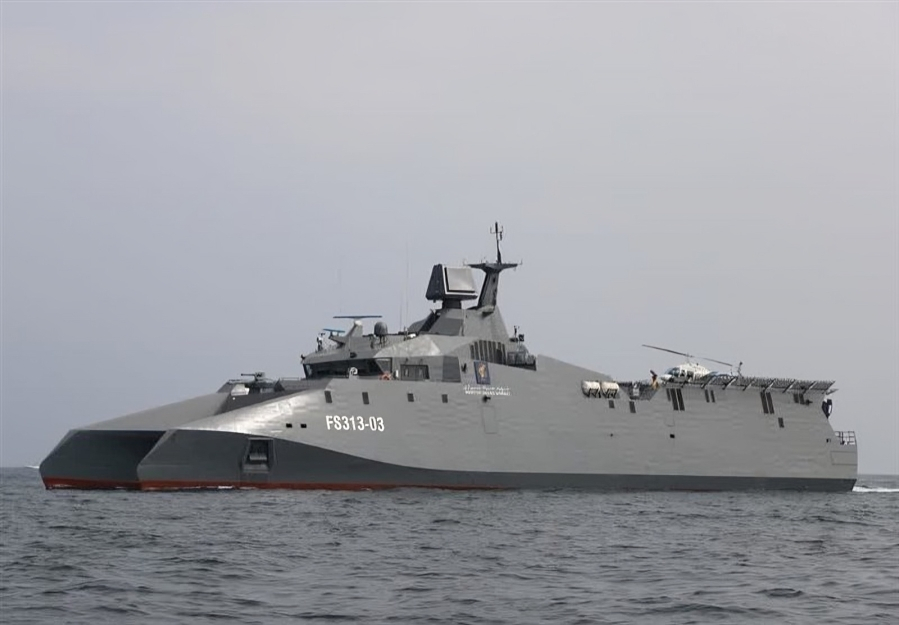The Navy of Iran's Islamic Revolution Guards Corps (IRGC) has received two new "stealth" patrol boats, marking a significant step in enhancing its maritime capabilities.
The Shahid Sayyad Shirazi and Shahid Hassan Baqeri warships, both Shahid-Soleimani class catamaran corvettes were unveiled in a ceremony in the southern port city of Bandar Abbas on February 19, according to Tasnim News Agency.
The two ships are ocean-going vessels with a speed of 45 knots and capable of covering 5,500 nautical miles, and they are 67 meters in length, 20 meters in width, weigh 600 tons and have four engines.
The report added that the warships could carry three light missile-launching boats and an armed helicopter and were equipped with offensive and defensive missiles, including vertically launched air defence Navvab missiles and Sayyad cruise missiles with a range of 700 km.
The IRGC Navy unveiled another vessel under the Shahid-Soleimani class in January, named after Abu Mahdi al-Muhandis. This radar-evasive vessel is capable of sailing for 14 days and covering 2,000 nautical miles, and it has a speed of 37 knots and can launch surface-to-surface missiles with a range of 35 km to 750 km.
On February 17, the Iranian Defence Ministry unveiled the Arman anti-ballistic and Azarakhsh low-altitude air defence systems.
The Arman anti-ballistic system can identify targets up to a range of 180 km and can fire at 12 targets. It had a radar installation and three Sayyad 2 and 3 class launchers (TELAR: Transporter Erector Launcher and Radar) installed on the same vehicle, to which two mobile launchers with six vertically launching missiles each could be attached.
The Azarakhsh short-range defense system can reportedly hit targets up to 50 km range with four missiles. It could be mounted on all types of vehicles and perform operations day and night under any weather conditions using an advanced three-dimensional radar system, optical search and advanced seekers.
These announcements come amid rising tensions in the Persian Gulf and the Red Sea, highlighting Iran's ongoing commitment to bolstering its military capabilities despite international pressures.
On February 14, the IRGC Navy unveiled new cruise missile systems around the three Iranian-controlled disputed islands, Abu Mousa, Greater Tunb and Lesser Tunb and their surrounding waters in the Persian Gulf.
These cruise missile systems with a range of 300 to 700 km have been introduced, capable of being fired while in motion. This advancement allows for momentary displacement of the missile systems, reducing the likelihood of detection.
The new cruise missile systems and advanced speedboats demonstrate the technological evolution of the Iranian navy, aimed at increasing its operational range and deterrence capability in the strategic waters of the Persian Gulf.
In addition to these missile systems, Iran introduced three advanced high-speedboats, capable of carrying long-range missiles. The design and construction of the advanced speedboats focus on flexibility and continuity in navigation, with the boat material shifting from fibreglass to aluminium.
These boats uniquely feature the capability to carry a missile with a range of 30 kilometers, boasting destructive power and high precision, on an eight-meter boat.
In recent years, Iran has significantly expanded its naval force, reflecting its ambition to enhance its strategic presence in the Persian Gulf and beyond. This expansion includes the commissioning of advanced submarines, such as the Fateh class, and warships equipped with modern missile technologies.
Iran has also focused on producing fast and maneuverable boats, capable of launching asymmetrical attacks against larger ships, thereby enhancing its ability to conduct Anti-Access/Area Denial (A2/AD) operations in critical areas.
Simultaneously, innovations in maritime drones and cruise missile systems underscore Iran's approach to diversifying its means of defense and attack at sea, aiming to assert its regional sovereignty amidst rivalries and international pressures.
IRGC Aerospace Force Commander Brig Gen Amir Ali Hajizadeh said on February 15 that his forces can strike maritime targets or perform reconnaissance operations at any location using their "advanced stealth drones".
Hajizadeh's remarks came amid heightened tensions in the Red Sea and the Gulf of Aden, where the Iran-backed Yemeni Houthi rebels are targeting commercial ships, reportedly linked to Israel, as a response to Israel's war in Gaza.







 President Ilham Aliyev shed light on the evolving contours of the peace process with Armenia during an international conference in Baku this week. ...
President Ilham Aliyev shed light on the evolving contours of the peace process with Armenia during an international conference in Baku this week. ...
 Azerbaijan and Armenia started the process of demarcation of their border on Tuesday, with the installation of the first border markers based on ge...
Azerbaijan and Armenia started the process of demarcation of their border on Tuesday, with the installation of the first border markers based on ge...
 President Aliyev emphasized the critical role of the North-South Transport Corridor in fostering transport cooperation between Azerbaijan and Russi...
President Aliyev emphasized the critical role of the North-South Transport Corridor in fostering transport cooperation between Azerbaijan and Russi...
 Iran and Pakistan have signed eight cooperation documents in various fields, and agreed to strengthen ties to fight terrorism in the region.
Iran and Pakistan have signed eight cooperation documents in various fields, and agreed to strengthen ties to fight terrorism in the region.
 As the conflict between Ukraine and Russia escalates, the strategic importance of Kharkiv, Ukraine's second-largest city, has come sharply into focus.
As the conflict between Ukraine and Russia escalates, the strategic importance of Kharkiv, Ukraine's second-largest city, has come sharply into focus.
 Iranian President Ebrahim Raisi expressed Tehran’s readiness to participate in significant development projects in Sri Lanka during the inauguratio...
Iranian President Ebrahim Raisi expressed Tehran’s readiness to participate in significant development projects in Sri Lanka during the inauguratio...



